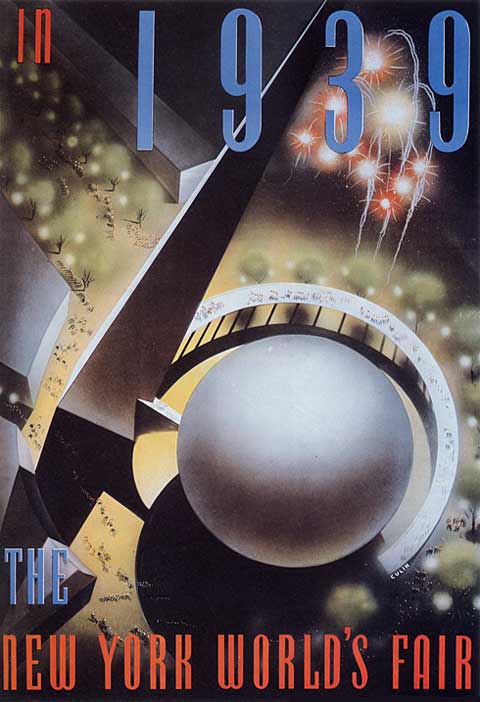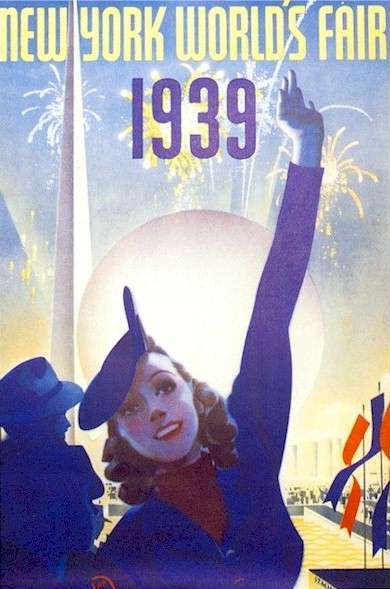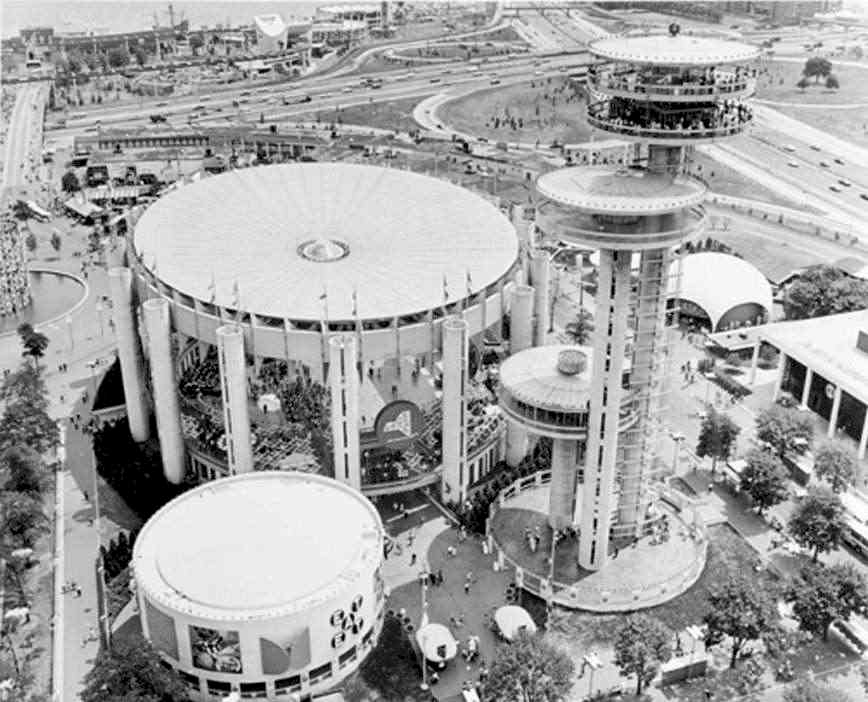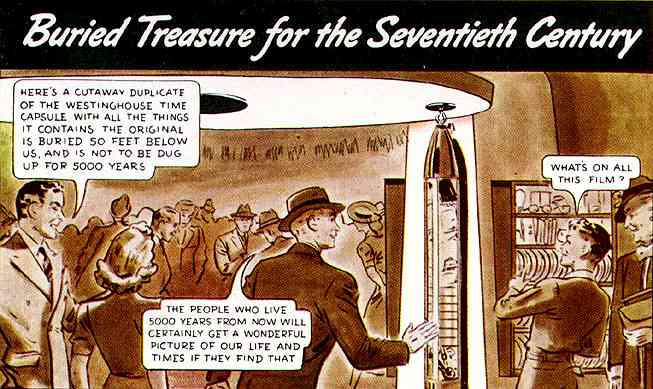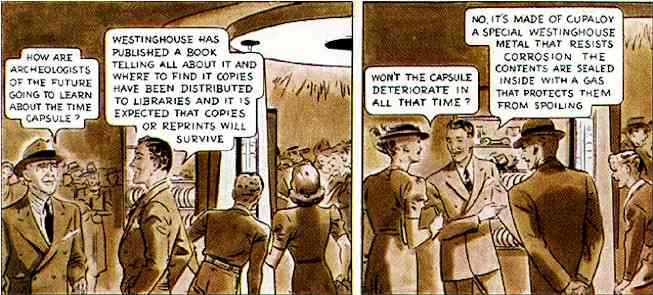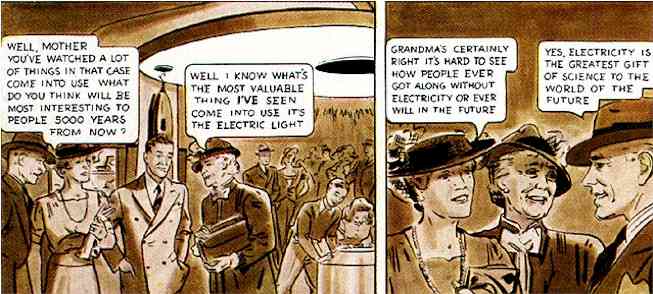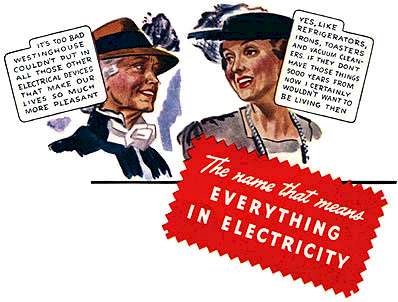An Extraordinary World's Fair
Year 1939 Saw Birth of Copier, Computer, TVMaybe we can show government how to operate better as a result of better architecture. - Frank Lloyd Wright by John Hillkirk
Window to the World: A television receiver gets a great deal of attention at the New York World's Fair in 1939. Ask any 70-year-old what he or she remembers most vividly about 1939, and the answer might be the lingering Depression. Or Europe preparing for war. Or FDR's New Deal. All those developments dramatically affected people's daily lives. Now zoom forward 50 years to 1989. Consider the technologies that permeate modern society: computers and copiers in our offices, microwave ovens in our kitchens, TVs in our living rooms, high-speed jets for travelling. Every one of those technologies appeared in 1939. The USA's John Atanasoff built the first computer. Chester Carlson patented his Xerox copier. RCA launched TV at the New York World's Fair. Germans flew the first jet-powered plane. Brits came up with microwave technology to detect enemy planes. No one is sure why so much happened at once. But 1939 certainly was the most important year in modem times for technological breakthroughs. Few of us could make it through the day without using a product dating to that incredible year. In any given period, there usually are one or two breakthroughs to marvel about. As Victor McElhaney, science historian at Massachusetts Institute of Technology, says, "We've been living in a technological revolution for 350 years." The 1970s marked the birth of gene-splicing and personal computers, the '80s reusable space shuttles and cellular phones. But certain years boast an astounding number of breakthroughs that significantly alter the way we live. In 1876, the car engine and telephone were invented within two weeks of each other. Soon after that, Thomas Edison's incandescent light flickered on. But in 1939, "it's pretty clear there was a renaissance," says John Hench, 81, who joined Walt Disney in 1939. "There was some kind of consciousness, some kind of special love in the air that hasn't been seen since." Flashes of genius by inventors working on their own birthed most of the dazzling discoveries of 1939. The inventors weren't striving for money or fame. They genuinely were looking for a way to improve people's lives. And they lived in a simpler world, where the inventor's tradition of tinkering - of manipulating objects, not symbols - was still part of daily life. "People weren't so fat and lazy back then," says Dale Whitford, a University of Dayton aerospace researcher. "Everybody was striving to get better, to improve their standard of living - just like the Japanese and Koreans are now." As often happens, inventors had a miserable time convincing people that their ideas would work. IBM refused to buy Atanasoff's computer and Carlson's copier, the British and Germans ignored jets. But the inventors stuck with it. Here's a glimpse of what a few of them experienced:
Those discoveries, and other significant 1939 breakthroughs - TV, nylon, the atomic bomb and microwave technology - were spurred by some events of that era:
Lately, the big breakthroughs have trickled off. Says Whitford: "You might speculate that the easy thing; have been accomplished." But the renaissance men of 1939 say much remains to be done. The secret is to consider ideas from any source, to be willing to listen to ideas that sound outlandish, even faintly ridiculous. "The great inventors tend to get the crackpot image put on them," says Whitford, a close friend of Von Ohain's. "But usually that's because they're too far ahead of their time." Source: USA Today Friday 1 December 1989
Trylon and Perisphere: the 1939 World's Fair
An early prospectus read, "The Fair will dramatically display the most promising developments of ideas, products, services and social factors of the present day in such a fashion that the visitor may gain a vision of what he might attain for himself and for his community by intelligence and cooperative planning." Ignoring the darkening clouds of war, Grover Whalen, the Fair's gregarious president, described its aim as "to place en route the world's resources in a gigantic crusade against man's chief foes: inertia, lassitude, and chance." President Franklin Delano Roosevelt addressed the opening day crowds in a seminal television broadcast; Albert Einstein threw the switch that electrified the Fair's phantasmagorical lighting systems; and New York's mayor Fiorello La Guardia was described by NBC television as the most "telegenic" man at the Fair. The Fair's central theme exhibit, Democracity, was a multimedia extravaganza portraying America in 2039 as a harmonious network of urban, suburban, and rural areas. "This is not a vague dream of a life that might be lived in the far future," wrote a Fair official, "but one that could be lived tomorrow if we willed it so." The Fair's provocative, often symbolically designed pavilions were organised into seven thematic zones featuring the aspects of modern life that wed man and machine:
Futurama, Norman Bel Geddes' extravaganza for General Motors, was the most ambitious and visionary multimedia educational entertainment ever built. After waiting an average of two hours, visitors took their places in comfortable, high-sided chairs to set out on a simulated airplane ride over the American landscape of 1960, featuring express highways, radio-controlled cars, massive suspension bridges, and modern high-rises. Visitors stepped from their seats into a full-scale realisation of the latest model they had seen. Upon exiting Futurama, dazzled spectators received an "I have seen the future" button, a treasured badge of honour matched only by the Heinz pickle pin. The Fair was shaped by other outstanding exhibits, some with social, but most with commercial, messages.
It was a fair of lasting firsts.
"The visitor who wants to get the most out of this World's Fair will do best to regard it not as a show of things," wrote H G Wells in The New York Times, "but let his imagination off the leash of discretion for a bit. Then he may really get a glimpse of the realities of tomorrow that lurk in this jungle of exhibits. It will cease to look like a collection of things for sale and reveal its real nature as a gathering of live objects, each of which is going to do something to him, possibly something quite startling, before he is very much older." Wells was right, for the Fair did sweep the visitor up into the grandest illusion of the century. Walking among its richly coloured streets, fairgoers became part of a great experiment that conditioned them to yearn - among other things - for the material goods displayed in the name of progress. "The World of Tomorrow is arranged not as the visible rendering of a utopian dream but to assemble before us what can be done with human life today," continued an exuberant Wells, "and what we shall almost certainly be able to do with it, if we think fit, in the near future." Source: Poster by Albert Staehle from Trylon and Perisphere: The 1939 New York World's Fair by B Cohen S Heller and S Chwast
Dreamland?
nypl.org Thanks to Thomas Foley, I now know that
the above photo is from the 1964 - 65 NYWF, not the 1939 - 40 NYWF. The ideals of the 1939 - 40 New York World’s Fair certainly had their limitations, which the rest of 20th century America has met, but the wonder and awe which surrounded it has not subsided. In the context of the 21st century’s view of technology, 1939’s view of the future even takes on an aura of nostalgia. The World of Tomorrow was a dreamland, and it remains so, a work of art incomplete yet planned well into "the future." The fair is a time capsule unto itself, filled with kitsch and theoretical salvation, a rare icon of hope in the 21st century, ready to be opened time and again for future generations. The 1939-40 New York World’s Fair is both yesterday and tomorrow. Source: xroads.virginia.edu
The Time CapsuleThe Time Capsule! Fascinating alike to scientists and to everyday folks, this record of our times has been prepared for the eyes of a civilisation 5000 years away. But your own eyes can see a cut-away duplicate of it, with all its contents, if you join the Middletons - Babs and Bud, their parents, and Grandma - at the Westinghouse New York World's Fair Building. Visit the Halls of Power and Electrical Living... see the Playground of Science; the Microvivarium; Elektro, the Moto-Man, and many other electrical marvels. A warm welcome awaits you at this "fair within a fair." Source: sjsu.edu
(The Middletons were designed to represent a typical upper-class family visiting the fair.)
Source: sjsu.edu See also:
For IT-related articles on snooping, usage, the future, e-diaries, piracy, flickers, cyborgs, browsing, trends, jokes, philosophic agents, artificial consciousness and more,
press the "Up" button below to take you to the Table of Contents for this Information and Technology section. |
 Animals
Animals Animation
Animation Art of Playing Cards
Art of Playing Cards Drugs
Drugs Education
Education Environment
Environment Flying
Flying History
History Humour
Humour Immigration
Immigration Info/Tech
Info/Tech Intellectual/Entertaining
Intellectual/Entertaining Lifestyles
Lifestyles Men
Men Money/Politics/Law
Money/Politics/Law New Jersey
New Jersey Odds and Oddities
Odds and Oddities Older & Under
Older & Under Photography
Photography Prisons
Prisons Relationships
Relationships Science
Science Social/Cultural
Social/Cultural Terrorism
Terrorism Wellington
Wellington Working
Working Zero Return Investment
Zero Return Investment

